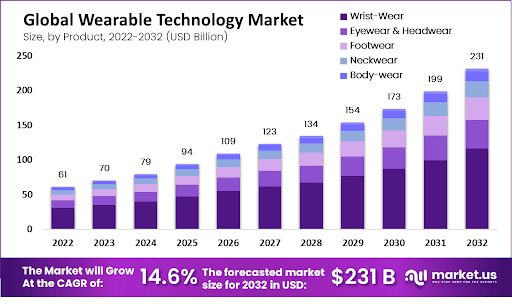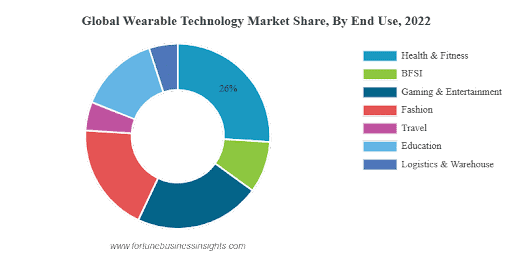Expanding Wearable Technology in Business: Opportunities and Benefits
Technology has not just remained a technical term, As it this now become an essential part of human lives. The development of various innovatively advanced tech solutions is completely revolutionizing the lives of people in exchange for ease. In the current times, the development of wearable technology is also expanding its span and providing many advantages. As we look forward to the increasing realm of wearable technology from the business perspective, we uncover a world with ample possibilities. The current wearable technology is way beyond traditional technology, continuously changing our living standards. Wearable technology in business can lead to a bunch of opportunities. Which are availing real-time data analysis for easy incorporation into various business procedures. Devices based on this technology provide different advantages such as enhancement of productivity, healthcare &fitness-aided solutions, wireless readability, and ideals for some critical diseases.

Due to these advantages and many other features, this wearable technology is expanding on a larger worldwide scale. The research data by Market.us highlights statics in the same context. As shown in the above figure, the global wearable market worth is expected to increase by USD 231 billion by 2032 with a compound annual growth rate (CAGR) rate of 14.60%. Which involves product categories like wristwear, footwear, eyewear & headwear, neckwear, and bodywear. This shows the effective and growing presence of wearable technology on a global scale. This technology is defined as electronic devices and products that can directly be connected to the human body or worn as a form of accessory.
Blog Highlights
This blog is all about embarking on the journey of exploring the expanding nature of wearable technology. In which the major highlights will be the advantages of this technology growth from a market perspective and recently emerging trends or solutions of this technology. Let’s read this compiled narrative of literature and access endless mobile applications in business for wearable technology.
Benefits of Wearable Technology in Business
Society is way more forward when it comes to healthcare and fitness. This is the major domain from which the journey of wearable technology started to develop and continuously increase. But in the current times, many fitness app development services are expanding their area and providing different advantages. Which are explained further.
1. Healthcare and Fitness Tracking
Wearable devices, such as fitness trackers and smartwatches, offer comprehensive health and fitness monitoring capabilities. They provide users with real-time data on physical activity, heart rate, sleep patterns, calorie consumption, and more. This information empowers individuals to make data-driven decisions about their health and fitness routines, helping them set and achieve personal wellness goals. Whether it’s tracking daily steps, monitoring sleep quality, or analyzing heart rate trends, wearables have become valuable companions in the pursuit of a healthier lifestyle.
2. Efficient Communication
The integration of wearable tech amplifies communication efficiency. Users can send and receive messages, make calls, and even attend virtual meetings directly from their wrist or eyewear, eliminating the need to reach for a phone. This streamlined communication fosters faster response times and enhances connectivity, making it a valuable tool for professionals juggling multiple tasks and commitments.
3. Convenience and Accessibility
The current times are of ease and wearable technology solutions enhance user convenience by providing quick and effortless access to information, notifications, and apps. Instead of fumbling for a smartphone, users can conveniently glance at their smartwatches or smart glasses to check messages, receive alerts, and access essential apps. This convenience is particularly beneficial for busy professionals and individuals on the move, allowing them to stay informed and connected without disruptions to their daily activities.
4. Safety and Emergency Features
Almost every wearable device incorporates safety features that serve as lifelines in critical situations. Features like fall detection, location tracking, and SOS calls provide an added layer of safety and security. These functionalities can be crucial in emergency scenarios, ensuring that help is just a button press away.
5. Productivity Enhancement
Smartwatches and other wearables are designed to streamline task management and time tracking. They provide tools and apps that help users manage their schedules, set reminders, and track progress on various tasks. This enhanced productivity is particularly beneficial for professionals seeking to optimize their workday and meet their goals more efficiently.
6. Remote Control
This technology extends its utility beyond personal use. Many wearables can serve as remote control devices for other connected gadgets. Whether it’s adjusting music playback, managing smart home appliances, or even controlling presentations during business meetings, wearables simplify the process of remote device management.
7. Hands-Free Operation
Wearable technology allows for hands-free operation, which proves invaluable in scenarios where users’ hands are otherwise occupied. Whether driving, cooking, exercising, or engaging in any activity that requires the use of both hands, wearables grant users the freedom to access information, control devices, and stay connected without interruption.
8. Data Collection
Wearable devices and solutions play an important role in data collection for various purposes, from research to healthcare. The wealth of data generated, from activity patterns to biometric information, contributes to advancements in fields such as sports science, healthcare, and even epidemiology. This data serves as a valuable resource for researchers and professionals seeking to gain deeper insights into human behavior and health trends.
9. Style and fashion
Wearables come in a diverse range of designs and styles, catering to a wide spectrum of tastes and fashion preferences. Users can choose from elegant and classic designs for formal occasions or opt for sporty and casual wearables for active lifestyles. This fusion of technology and fashion allows users to express their individuality while staying connected and informed.
10. Monitoring and Management
Wearable devices have found a crucial role in medical and healthcare settings. They facilitate the continuous monitoring of patients’ health conditions, allowing healthcare providers to receive real-time data on vital signs, activity levels, and more. This data enables timely interventions and enhances patient care, particularly for individuals with chronic illnesses or those in post-surgery recovery.
Also Read: Building a Fitness App: A Step-by-Step Development Roadmap
Emerging Trends of Wearable Technology within the Market
Market trends majorly depend on the things that offer something unique to the consumers or focus on a consumer-centric approach. The development of wearable technology is considered to have a bright future and expanding growth. The research data by Fortune Business Insights highlights the same context. The below figure shows the possible trendy sectors of wearable technology. These categories are health & fitness, BFSI, Gaming & entertainment, fashion, logistics & warehouse, travel, and education. This indicates that wearable technology solutions are majorly inclined toward the sector of healthcare & fitness. This can be considered as a great opportunity for the fitness app development company as well as for the fitness app developers. Apart from the health and fitness app developers, many developers have worked on developing various advanced solutions based on wearable technology. These trends are mentioned further.

1. Head Mounted Display
This is the kind of wearable technology in which the wearer receives information directly in front of their eyes. While enabling a hands-free operation. The working capabilities of HDMs are to capture pictures, videos and effectively control other connected devices. The integration of such devices can be seen in fields like aviation, medicine, and military industries. With the emergence of augmented reality(AR) and virtual reality (VR) these devices become more supportive of learning experience.
2. GPS Trackers
The integration of wearable devices with GPS trackers can lead to many advantages. This works on monitoring the location of the wearer and provides location-based services. This is utilized by many health and fitness app developers to provide an effective fitness wearable device. These GPS sensors work on tracking the distance conveyed, speed, and routes of the wearing person during workouts.
3. Beacon Technology
The beacon technology works on the principle of Bluetooth low energy concept. This transmits signals to nearby devices to cover both online and offline activities. This provides many unique features such as accessing real-time location, indoor navigation of the users, and personalized advertising based on the user location.
4. Smart Clothing
Smart clothing, or electronic textiles holds various features like sensors, electronics, and connectivity, adding functionality beyond traditional garments. It offers convenience and portability, eliminating the need for separate devices. Smart clothing monitors vital signs for healthcare and tracks worker movements for safety and information in industrial contexts. It can also alert emergency contacts in case of accidents.
5. Wearable Heart Monitors
Continuous wearable heart monitors provide real-time heart rate tracking for cardiovascular health and fitness monitoring. They detect early signs of conditions like irregular heart rhythms and high blood pressure, facilitating prompt intervention. With improved sensors and AI algorithms, these devices are now smaller and more comfortable for daily use, remotely monitoring ECGs and minimizing the need for frequent doctor visits. Some models also track sleep patterns and include fall detection for alerting emergency contacts in case of accidents.
6. Hearable Device
The Hearables, commonly defined as earbuds or headphones, are worn in or around the ear. And often include advanced noise cancellation and equalizer settings. Many come with built-in fitness tracking, monitoring heart rate and steps, offering hands-free convenience. In healthcare, wearables serve as hearing aids for individuals with hearing impairments, improving communication. Some also provide real-time speech translation, benefiting travelers and those working in multilingual settings.
7. Bio-Sensors
Wearable biosensors encompass devices designed to oversee a range of physiological aspects, like heart rate, body temperature, and blood glucose levels. They serve various purposes in the realms of fitness tracking, disease management, and medical research. Additionally, biosensors play a crucial role in monitoring and tracking mental health factors such as stress, anxiety, and depression. This valuable data empowers both wearers and healthcare practitioners with enhanced insights into the wearer’s mental well-being, facilitating gradual, informed adjustments. Moreover, these cost-effective devices are instrumental in remote patient monitoring, reducing the necessity for frequent hospital visits.
Conclusive Outlines
As we delve into the expansive realm of wearable technology within the business landscape, we uncover a world brimming with possibilities. Beyond the confines of traditional fitness trackers, wearables have redefined how we interact with technology, seamlessly integrating into our daily professional lives. These versatile devices offer a wealth of opportunities, from real-time data analysis to effortless incorporation into various business processes. They empower individuals with actionable insights, transforming business operations from reactive to proactive. The future of wearable tech in business is unquestionably promising, promising improved productivity and more efficient operations. It’s not a matter of whether to embrace this technology but rather how to leverage its full potential. As business professionals, innovators, and organizations, we each have a role in shaping this exciting future.
Amplework, driven by an unwavering commitment to client satisfaction, has amassed substantial expertise in achieving impressive customer retention rates. With over 5+ years of combined industry experience, our organization has successfully delivered a wide range of mobile app development services, completing numerous projects and generating revenues exceeding $200 million. In this context, our proficiency extends to the evaluation and utilization of wearable technology within the business landscape.
Read More:- Learning Portal for Corporate Training



 sales@amplework.com
sales@amplework.com
 (+91) 9636-962-228
(+91) 9636-962-228





